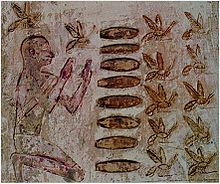Mellivory

Mellivory is a term for the eating of
Etymology
The word mellivory derives from the Latin mel, "honey", and -vorous, "-eating".[1]
Nutrition
Honey is a
Mellivory by humans

Food
Over its history as a food the main uses of honey have lain in cooking, baking, confection, as a spread on bread, as an addition to various beverages such as tea, and as a sweetener in some commercial beverages.[5]
Due to its energy density, honey is an important food for virtually all hunter-gatherer cultures in warm climates, with the Hadza people ranking honey as their favorite food.[6] Honey hunters in Africa have a mutualistic relationship with certain species of honeyguide birds.[3][7]
Fermentation
Possibly the world's oldest
Mead varieties include drinks called
Traditional medicine
Honey is a
In myths and
Religious consumption
Humans consume honey as parts of some religions. In Judaism during
Mellivory by nonhuman animals

By invertebrates
There are several species of insects that are considered
By vertebrates
Honey is eaten by several types of mammals, notably
Honey and beeswax are also eaten by some birds, including honeyeaters and honeyguides, the latter of which are known to guide humans to bee colonies in order to partake in foraging mutualism.[7]
Mellivory by microorganisms
Honey, despite having limited antimicrobial properties,[4] is consumed by some microorganisms, particularly yeasts and spore-forming bacteria.[28] Notable fungi found in honey are Alternaria alternata, Aspergillus niger, Aspergillus proliferans, Aspergillus spelunceus, Chaetomium globosum, Cladosporium cladosporioides, Daldinia concentrica, Emericella discophora, Emericella qinqixianii, Penicillium corylophilum, Penicillium decumbens, Penicillium polonicum, and Penicillium echinulatum, while notable bacteria species are Debaryomyces hansenii, Zygosaccharomyces rouxii, Zygosaccharomyces mellis, Aureobasidium pullulans, and Cryptococcus uzbekistanensis.[29]
References
- ^ "Definition of MELLIVOROUS". www.merriam-webster.com. Retrieved 2022-09-26.
- ^ "What is Honey?". Food Insight. 2020-12-23. Retrieved 2022-09-21.
- ^ a b c Wayman, Erin. "Humans, the Honey Hunters". Smithsonian Magazine. Retrieved 2022-09-26.
- ^ PMID 23569748.
- PMID 367113
- PMID 24746602.
- ^ S2CID 206648494.
- PMID 15590771.
- ^ hdl:10198/16120.
- ^ PMID 25153872.
- ^ Tierney, John (21 October 2014). "Making Mead in a Space-Age World". The Atlantic. Retrieved 20 June 2017.
- ^ "Braggot: The Best of Mead and Beer". American Home Brewers Association. 2017. Retrieved 19 June 2017.
- PMID 25742878.
Honey appears to heal partial thickness burns more quickly than conventional treatment (which included polyurethane film, paraffin gauze, soframycin-impregnated gauze, sterile linen and leaving the burns exposed) and infected post-operative wounds more quickly than antiseptics and gauze.
- ISBN 978-1603429870.
- ISBN 9781439840160.
- PMID 23888738.
- ISBN 978-981-4335-66-9.
- ^ Rema, Orach Chaim 583:1.
- ^ Bramen, Lisa. "Why Honey Is Eaten for Rosh Hashanah, and Other Burning Questions". Smithsonian Magazine. Retrieved 2022-09-26.
- ^ a b A Meaningful Story of Buddha, Elephant and Monkey Archived 19 March 2008 at the Wayback Machine by Marguerite Theophil, United Press International, 16 November 2006, accessed 9 August 2008
- ^ Yusuf 'Ali, 'Abdullah. An Nahl, Al-Quran Chapter 16 (The Bee) quoted from "The Holy Qur'an: Original Arabic Text with English Translation & Selected Commentaries". Saba Islamic Media. Archived from the original on 26 February 2013. Retrieved 20 May 2013.
{{cite book}}: CS1 maint: bot: original URL status unknown (link) - ^ "ENY-163/IN1064: Robbing Behavior in Honey Bees". edis.ifas.ufl.edu. Retrieved 2022-09-22.
- ^ "About The Nomad Bee - Species, Life Cycles And Hosts". BuzzAboutBees.net. Retrieved 2022-09-22.
- ^ "5 Animals That Love Raw Honey". Manuka Honey USA. 2018-05-28. Retrieved 2022-09-20.
- ^ Manning, Elizabeth. "ASK A WILDLIFE BIOLOGIST, Alaska Department of Fish and Game". www.adfg.alaska.gov. Retrieved 2022-09-21.
- ^ Stievater, Becca (26 June 2019). "Beehive Fences to Deter Both Elephants and Honey Badgers". wildnet.org. Retrieved 20 September 2022.
- ^ Zielinski, Sarah. "Honey Badgers Are Real". Smithsonian Magazine. Retrieved 2022-09-23.
- PMID 8880294.
- ISBN 978-953-51-2879-3.
